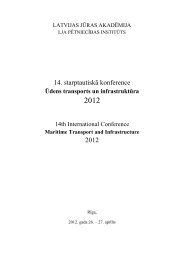You also want an ePaper? Increase the reach of your titles
YUMPU automatically turns print PDFs into web optimized ePapers that Google loves.
as base. The persons included in base have entries about maritime education gained in particular timeperiod. Data about their employment was added for analysis of their work on board after graduation.The research consists of four steps:1. identification of size and composition of active seafarers’ pool and determination of main agegroups for entrants and seafarers who leave the pool by analysing average age structure ofseafarers in the pool;2. determination of overall contribution of <strong>Latvian</strong> maritime training and education institutionslooking to supplied qualifications and numbers of new seafarers;3. comparison between the total numbers of graduated persons with graduates who worked onboard the ships after graduation;4. determination of time period graduates worked in active seafarers’ pool to determine leaving ratefor shore jobs after graduation. Additionally the career growth on board is determined andcompared between graduates from different institutions taking into account the level ofparticular programme.The limitation of this research lies in fact that it is difficult to validate the outcome of those analysisagain other data source as there is limited possibilities to get similar data covering whole seafarers’ poolin Latvia. The outcome probably can be validated again the results of extensive and expensive surveytherefore it is not credible that it will be done in foreseen future. Also the data about employment cannotbe considered as 100% exact as part of <strong>Latvian</strong> seafarers are employed directly by foreign companies andthe data of this employment is entered in database when person comes to seamen registry for certificationreasons. However due to the number of persons included in sample it can be assumed that values are closeto average values and therefore they are fully usable.2. Basic concept of seafarers’ poolFigure 1 shows simple seafarers’ resource model. <strong>Maritime</strong> education, active seafarers and ex–seafarers are considered as the main three blocks of model. <strong>Maritime</strong> education system provides theentrants for active pool and main parameters of maritime education system are qualification gained ineducational process and number of graduates. Most of the persons join the pool at age 20 - 29 years asmost persons graduate from maritime education institutions within this age range.Figure. 1. Model of seafarers’ resources (author)The assumption of entering age is also supported by the average age structure of merchant seafarers(Figure 2). The relative number is increasing till age group 25 – 29 years when it reaches highest value.Also retirement age can be derived from age structure of seafarers and considered at age 60-64 years asthere is drop by 4% comparing with age group 55-59 years. Only 2% of seafarers are represented in agegroup over 65 years.6
















